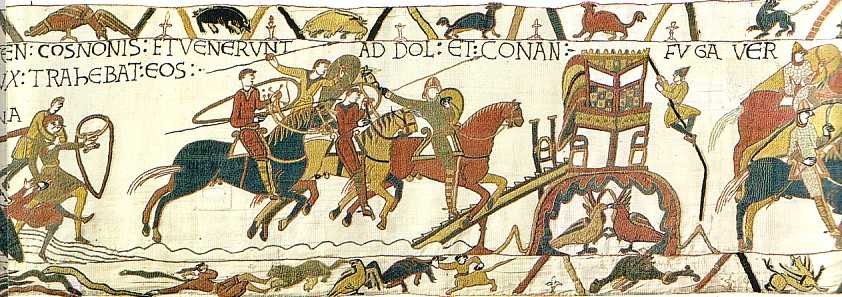
...HAVE COME TO MONT ST. MICHEL - AND HERE THEY HAVE CROSSED THE RIVER COUESNON - HERE DUKE HAROLD...
It seems that a certain count Conan did not own himself as the subject of a Norman duke. In this scene the Norman army has ridden out, and we see armored troops for the first time (a pair of fighting "cocks" are seen inside the motte of Dol castle, below, a graphic statement of the impending conflict). War has been declared and therefore violent action could break out at any time as the Normans cross the frontier into Brittany. William is not armored at all: he wears the second example of that curious diamond-pattern coat. His "baculum" is all that he carries in the way of weapons: and as the Tapestry makes clear later on, this - like the ancient Roman tribune's "vitus" and modern British officer's swagger stick - is a badge of high rank.
The shield grips are interesting, because with only a few exceptions, the arrangement is a simple horizontal strap that is held by erecting the forearm into a vertical position: although the guige (shoulder strap) is not usually depicted, this would be absolutely required to keep the shield arm from becoming rapidly fatigued, and to further control the shield.
The horseman two in the lead of the duke is rolling from the saddle to dismount and cross the Couesnon on foot. Others were not so wise and got into mortal difficulties in the tidal flats. The first of these can be seen already tumbling to his doom over the neck of his foundering horse. Other soldiers carry sheilds overhead to keep them dry - though why they would leave their swords and scabbards on their belts is beyond me and must be an oversight of the artists.
Mont St Michel, a famous abbey and landmark, positively locate this crossing point. The seated figure in the upper border is pointing to the abbey and holds onto a staff or ornate serpentine part of the bench on which he sits. Other than maybe being part of another fable I have no idea what he signifies.
...PULLED THEM FROM THE QUICKSAND - AND THEY HAVE COME TO DOL AND CONAN HAS TURNED IN FLIGHT
The lower border is used positively for the first time to augment the main panel action. Treacherous-looking sea creatures lurk unseen beneath the water. Evidently Harold was unable to save all the drowning victims, as one at least has slipped down to lie amongst the eels. (Someone can bring my ignorance of fables up to speed: but it looks like the animals fastened upon each other is another Aesop, with a curious "centaur" creature getting the best of this game.)
Harold is holding the clearest depiction in the Tapestry of a standard four-strap arrangement on his shield, complete with guige for helping to bear the weight or slinging over the back when not in use. The fact that he is carrying his shield with one hand while rescuing the men is intended to demonstrate his famous physical prowess. He was one of those legends in his own time.
Apparantly the swiftness of William's invasion of Brittany caught poor Conan off-guard. The Norman knights are riding without armor, but are otherwise fully-equipped and even helmed. These could be light cavalry - not knights - but just as well they could be knights riding to arrive swiftly to achieve surprise. Conan is without armor as well. Probably he had not even gathered his troops as yet, and perhaps was still bargaining with William. In fact he was not even there when the Normans arrived, having already fled. But such niceties are hard to portray in a series of pictures.
Some of the details here are worth mentioning: all the horsemen except the rear one are using the simple shield straps. The rear man is gripping his four-strap arrangement in the center, rather than using them as a set of straps that he could put his arm through. The leading man has a helmet with a neckguard. This is the first scene of cavalry in combat. The leading man is about to throw his spear as a javelin; two spears (lances) are definitely couched underarm, while the horseman in the background seems to be merely brandishing his weapon.
RENNES - HERE THE SOLDIERS OF DUKE WILLIAM FIGHT AGAINST...
The cavalry are now fully-armed and not a light horseman among them. William chased Conan to Rennes and then on to Dinan, advancing deeper into Brittany. Rennes is depicted as a simple motte-and-bailey castle (the bailey is dispensed with in the Bayeux Tapestry for reasons of simplicity and available space). This is not the town proper, but the castle attached to it.




